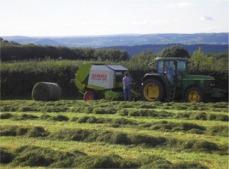Grass
 Grassland supports the entire dairy, beef, sheep and equine industries and silage, hay and haylage are every bit as important as any other crop grown in the UK.
Grassland supports the entire dairy, beef, sheep and equine industries and silage, hay and haylage are every bit as important as any other crop grown in the UK.In the past, the problem has been one of over-familiarity; the grass grows most of the year round, has always been there, some years it makes good hay and silage, some years it doesn't. Over the years it has done progressively less well and we have been encouraged to plough up and re-seed more and more often. New ryegrasses need more nitrogen and the more nitrogen you apply, the lower the essential mineral content of the grass. The supposed answer is to feed more mineral supplements and more cake - or is it? Actually a much better way is to re-mineralise the soil and maintain productive swards of diverse, non-nitrogen-dependent species capable of delivering an adequate supply of nutrients.
The much-derided, "inefficient" old mixed farm represented an almost closed circle in the days before the internal combustion engine. The farm lived off its assets for most of the year and at harvest the surplus was sold off, providing the wherewithal for the following year. Simple, but effective. Grassland was grassland, either because it was in rotation, or because it was not suitable for anything else. Ruminant animals then and now represent the most efficient way of converting indigestible cellulose into meat and dairy products. The arguments about global warming caused by cattle flatulence are risible and represent one-dimensional thinking from earnest academics who are unlikely ever to have stepped off concrete.
Grassland in places like the UK will still be used for rearing livestock long after these "experts" have stepped off the mortal coil. What must change however is the way in which we manage it. Elsewhere in this website we make the case for grass fed beef, because the point is we have to move to more sustainable systems. There is no point in using 10kg of cereal to produce 1kg of meat, but there is every reason to use grassland for that purpose, particularly in high rainfall and upland areas. Dairying also needs a re-think in the longer term. We need grass fed, long life dairy cows whose male progeny make adequate beef animals. It can be done and is being done on a small scale in the organic system, but it is likely to take a long time to bring about change in the wider industry.
At Field Science we ‘cut our teeth’ treating grassland. By treating your cutting ground you will ensure not only that the silage will be correctly and fully mineralised for the winter but also young stock grazing the aftermath will not suffer the usual growth check due to the cut crop having taken the nutrients. There will still be plenty for the next two years (subject to the soil’s ability to retain nutrients).
Hay and haylage sold off the farm can achieve a price premium due to its mineral enrichment – the more natural way to supply minerals to horses than supplements and far more efficient.
